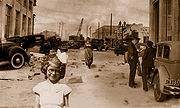
Field Act
Encyclopedia

California
California is a state located on the West Coast of the United States. It is by far the most populous U.S. state, and the third-largest by land area...
) in the United States
United States
The United States of America is a federal constitutional republic comprising fifty states and a federal district...
. The Field Act had its genesis in the 6.3 magnitude 1933 Long Beach earthquake
1933 Long Beach earthquake
The Long Beach earthquake of 1933 took place on March 10, 1933 at 17:55 PST , with a magnitude of 6.4, causing widespread damage to buildings throughout Southern California. The epicenter was offshore, southeast of Long Beach on the Newport-Inglewood Fault. An estimated fifty million dollars worth...
which occurred on March 10 of that year and destroyed or rendered unsafe 230 school buildings in Southern California.
Many school buildings had completely collapsed due to unreinforced masonry construction and/or shoddy workmanship. Fortunately, the earthquake occurred at 5:55PM on a Friday, just a few hours after school had let out. Had the earthquake occurred while school was in session earlier that afternoon thousands of casualties, mainly children, would have likely occurred. Public awareness of this nearly averted tragedy led to passage of the Act within 30 days of the quake by the California State Legislature
California State Legislature
The California State Legislature is the state legislature of the U.S. state of California. It is a bicameral body consisting of the lower house, the California State Assembly, with 80 members, and the upper house, the California State Senate, with 40 members...
. The Act was named after California Assemblyman Charles Field, the key sponsor of the legislation.
Provisions of the Act
The Field Act was introduced with other laws that banned unreinforced masonry construction, and required that earthquake forces be taken into account in structural design (specifically, a new requirement for a base shear calculation, and that school buildings must be able to withstand lateral forces equal to at least 3% of the building total mass).The Act also established the Office of the State Architect (now Division of the State Architect
Division of the State Architect
Many national governments and U.S. states have a public official titled the state architect. The specific duties and areas of responsibility of state architects vary, but they generally involve responsibility for the design and/or construction of public buildings in the state...
or DSA) which developed design standards, quality control procedures, and required that schools be designed by registered architects and engineers. These professionals must submit their plans and specifications to the State Architect for review and approval prior to construction. The same professionals were also required by the Act to periodically inspect the construction while underway and verify that the actual work completed is in compliance with the approved drawings. Peer review was also introduced as another quality control procedure.
The Garrison Act
In 1939 the Garrison Act applied Field Act Standards to existing school buildings. The first real world test of the Field Act took place in the 1940 Imperial Valley earthquake1940 El Centro earthquake
The 1940 El Centro earthquake struck on 18 May 1940, due to a rupture of the Imperial Fault, and was the strongest recorded earthquake to hit the Imperial Valley...
. This earthquake was magnitude 7.1 (larger than the Long Beach Earthquake) but the 16 post Field Act school buildings subjected to intense shaking suffered damage that was less than 1% of their valuation. Older pre Field Act structures in contrast suffered damaged equal to 29% of their valuation.
The Green Acts
Although the benefits of the Field Act were clearly demonstrated by this event, many districts still delayed inspecting or renovating older pre-Field Act structures. As a result, the first and second Green Acts were passed in 1967 and 1968 respectively to set inspection deadline for school districts. The 1971 San Fernando earthquake spurred the State Legislature to provide additional funding to retrofit older buildings.Current application
As of 2010, the Field Act currently applies to the design, construction and renovation of all K-12K-12
K–12 is a designation for the sum of primary and secondary education. It is used in the United States, Canada, Australia, and New Zealand where P–12 is also commonly used...
school buildings and Community College
Community college
A community college is a type of educational institution. The term can have different meanings in different countries.-Australia:Community colleges carry on the tradition of adult education, which was established in Australia around mid 19th century when evening classes were held to help adults...
buildings in California. Although there have been attempts to make private schools comply with the provision of the Field Act, they are currently exempt. The DSA remains the primary enforcement body, and also provides limited review of university buildings, primarily for disabled access issues. Since 1940, no building constructed under the Field Act has either partially or completely collapsed, and no students have been killed or injured in a Field Act compliant building.
Sources
(1) The Field Act and Public School: Construction: A 2007 Perspective – California Seismic Safety Commission Publication #CSSC 2007:03(2) Bracing for Disaster: Earthquake Resistant Architecture and Engineering in San Francisco, 1838–1933: Stephen Tobriner, 2006(3) Assessing Seismic Safety Policy: Daniel Barclay: MURJ Volume 10, 2004

